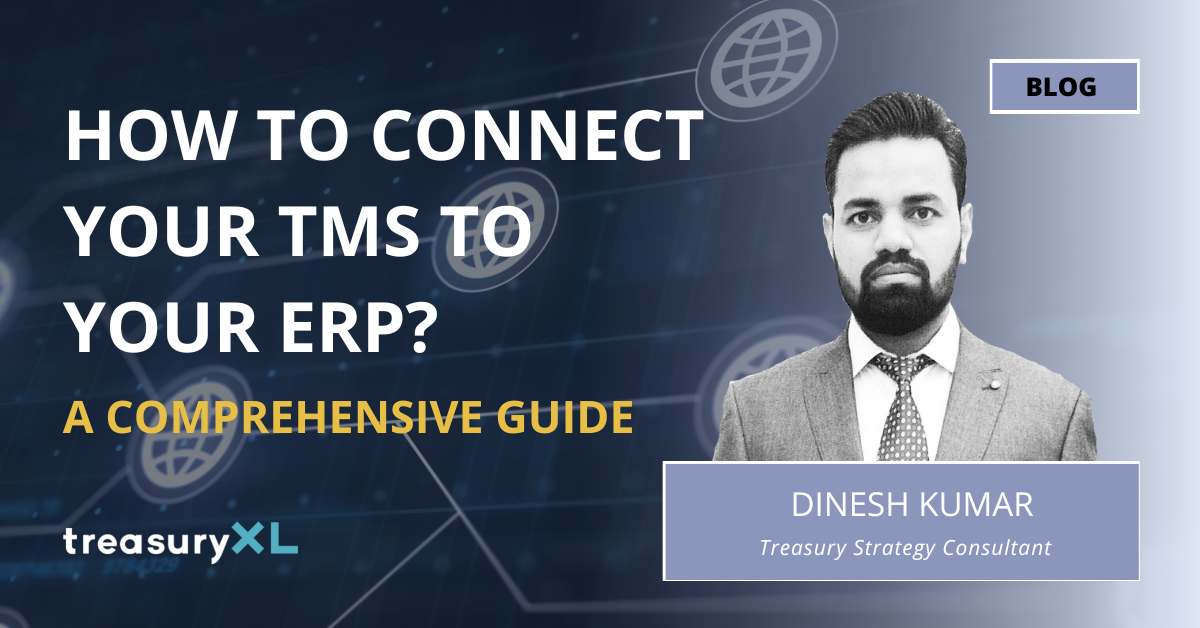How to connect your TMS to your ERP?
13-02-2023 | Dinesh Kumar | treasuryXL | LinkedIn |
Imagine a setting where your treasury management system (TMS) and enterprise resource planning (ERP) system work together seamlessly, like a well-oiled machine. In this case, your treasury team has real-time visibility into financial transactions and can make informed decisions quickly and efficiently. The process of connecting a TMS to an ERP system may seem daunting, but it’s a crucial step in achieving a more streamlined, efficient and accurate corporate treasury operation.

Companies deploy dedicated cash management solutions to manage their cash and commercial cashflows efficiently. They use a treasury management system (TMS) to manage financial risks or hedging needs using financial market instruments. A TMS often contains a cash management solution as one of its components.
TMS ERP System
Looking closer at the interface between the TMS and ERP systems, both directions (ERP to TMS and TMS to ERP) are relevant. Here are some examples:
- The ERP system publishes cashflow forecasts and payables/receivables for further consumption and processing in the TMS.
- The journal entries or the aggregated general ledger account balances from the treasury system are provided for upload to the ERP system.
We found the following to be critical information for any organization wanting to improve how their treasury systems connect:
- Automation
- Security need not be compromised
- IT does not need to be involved; in fact, IT should not be building interfaces or file formats
- Know your connectivity requirements and work with trusted advisors who can ensure you make the right technology investments for your needs. Not all solutions are the same.
Step-by-Step Guide to TMS and ERP Integration
Below are some steps that you can consider for TMS and ERP integration in your organisation.
Step 1: Identify the specific data and functionality
The first step in connecting your TMS to your ERP system is to identify the specific data and functionality that needs to be shared between the two systems. This may include things like Payments information, Bank reconciliation processing, data for cash forecasting, financial reporting, compliance, and risk management. By identifying these areas, you can ensure that the integration is tailored to your specific needs and that the benefits of the integration are realized.
The integration scenarios I have seen in my previous projects.
- Bank Connectivity
- Back Office Integration
- Payments and Cash reporting
Step 2: Evaluate the integration options
Once you have identified the data and functionality that needs to be shared, it’s time to evaluate the integration options available. There are a variety of options to choose from, such as using an API, middleware, or a pre-built integration solution. Each option has its own pros and cons, so it’s important to weigh the options and choose the one that best fits your needs.
Data mapping and data integration are also key considerations when connecting your TMS to your ERP system. This is the process of ensuring that the data fields and structures between the two systems match up correctly, so that data is transferred accurately. This can be a complex process, but it’s crucial for ensuring that the integration is successful.
Step 3: Implement the systems
Once the integration is complete, it’s time to implement the systems and perform any necessary configurations to meet your specific business requirements. This may include things like setting up permissions, creating custom reports, and configuring security settings.
Step 4: Test and validate the systems
For businesses with a variety of complex integration and workflows, testing each configuration that is established with the new ERP is critical before the “go-live” stage. After go-live, any unforeseen errors with data transmission, such as the incompatibility of certain formats or integration options, can cause significant delays and gaps and will almost always lead to treasury instituting manual workarounds. And because IT and external support teams will likely be less available to help fix these errors after the “go-live” and subsequent culmination of the project, ensuring that every touchpoint treasury maintains with the new ERP is functioning properly is essential. This step will likely require treasury’s collaboration with other departments like accounting and the c-suite as well as external banking and vendor teams to ensure that financial reports and data are being transmitted and received properly.
Step 5: Provide training and support
Providing training and support to users is also an important step in ensuring that the systems are used effectively. This may include providing training on how to use the systems, as well as providing ongoing support to address any issues that may arise.
Step 6: Change management to ensure ongoing success
Now, you will need to set up a robust change management team or enlist change management experts to help draw up a plan to bridge your current and future state. This plan will form part of your strategy that will need to be executed in parallel at the time of implementation. Change management is hard. Organizations, users, and systems don’t like changes, resist changes, and create hurdles that can derail a project. You can overcome a lot of this by having a strategic communication structure. Early communication, early buy-in from senior stakeholders, advanced notification, and transparent dialogue with end-users. You will not succeed by spooking those who will be most impacted by change. There will be intense courting to ensure strong adoption that needs to be supported with focused training. Bonus points if you can get everyone excited for change. Yes, that is possible.
So… what are the benefits?
The benefits of connecting your TMS to your ERP system are numerous. By having real-time visibility into financial transactions, your treasury team can make informed decisions quickly and efficiently. This can lead to cost savings, improved compliance and reduced operational risks. Additionally, having a well-integrated system can also lead to better forecasting and cash management capabilities, which can help your business stay ahead of the competition.
Conclusion
In conclusion, connecting your TMS to your ERP system can be a daunting task, but it’s a crucial step in achieving a more streamlined, efficient and accurate corporate treasury operation. By identifying the specific data and functionality that needs to be shared between the two systems, evaluating integration options, and ensuring that data is mapped and transferred accurately, you can ensure that the integration is successful. With the right tools, software, and support, your corporate treasury department can successfully implement a TMS-ERP integration and enjoy the many benefits it has to offer. So, don’t wait any longer, take the first step and start reaping the rewards today.
It may not be essential for every treasury professional to have an intimate knowledge of connectivity. After all, much of treasury’s connectivity is managed by software vendors and banks. But the more you know about connectivity, the more you’ll be able to understand your needs in terms of bank statements, payments, etc. You may find that you’ve been paying for services you don’t actually need, or there are services out there that you haven’t been getting that would make your life much easier. So take the time to educate yourself on connectivity.



